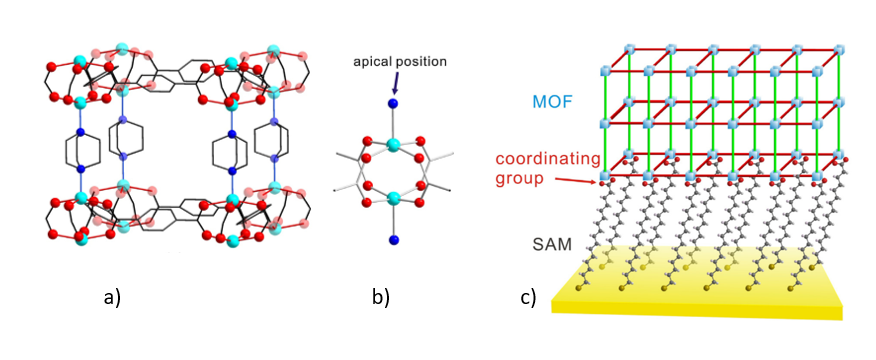Sonja Katzbach
Metal-organic frameworks (MOFs), that were first mentioned in the 1990s by the group of O. Yaghi[1], are a group of porous coordination polymers consisting of metal ions and multifunctional organic linkers. The selection of these primary building units determines the topology of the resulting two to three-dimensional MOF material.[2] The almost unlimited possibilities of organic synthesis allow for targeted design of functionalized organic ligand precursors and therefor the manipulation of chemical and physical properties of the resulting framework.[3] Due to their high surface area, chemical and thermal stability and numerous possible functionalization, MOFs are an interesting material for applications like gas storage and separation, catalysis and sensing.[4] The latter application makes use of host-guest-interactions between an analyte molecule and the MOF that change the framework's physical properties like weight, electronic or ionic conductivity and magnetic or dielectric properties. By transducing these changes into a physically measurable signal, MOF based sensors can be achieved.[5]
The main target of my research is the development of new sensor concepts for the detection of dipolar analyte molecules based on pillared-layer surface mounted metal-organic frameworks (SURMOFs). These MOFs can for example be prepared by the layer-by-layer method[6], where a MOF is deposited onto a substrate surface such as a self-assembled monolayer (SAM) functionalized gold substrate.[7,8] Pillared layer MOFs, that are also referred to as Kitagawa-MOFs[9], contain two different ligands: a carboxylate functionalized linker (L) that is bound to metal(II) ions (M) to form a paddle wheel motif and an N-heterocyclic pillar (P) that occupies the apical position to interconnect two paddle wheel motifs.

Schematic illustration of a) the typical structure of a pillared-layer MOF [M2L2P], b) the paddle wheel motif with occupied apical position and c) a SURMOF anchored onto a self-assembled monolayer (SAM)[7]
For this, new organic ligand precursors with embedded dipole moments perpendicular to the molecular axis are synthesized. These linkers are used to prepare bulk-MOF material and to deposit SURMOFs on suiting substrate surfaces for sensing purposes. In order to characterize the formed material, various analytical methods, such as XRD (X-ray diffraction) and IR spectroscopy are used.
[1] Yaghi, O. M.; Li, H.; Davis, C.; Richardson, D.; Groy, T. L. Synthetic Strategies, Structure Patterns, and Emerging Properties in the Chemistry of Modular Porous Solids. Acc. Chem. Res. 1998, 31, 474–484.
[2] M. Eddaoudi, D. B. Moler, H. Li, B. Chen, T. M. Reineke, M. O’Keeffe, O. M. Yaghi, Modular chemistry: Secondary building units as a basis for the design of highly porous and robust metal-organic carboxylate frameworks, Acc. Chem. Res. 2001, 34, 319–330.
[3] W. Lu, Z. Wei, Z. Y. Gu, T. F. Liu, J. Park, J. Park, J. Tian, M. Zhang, Q. Zhang, T.Gentle et al., Tuning the structure and function of metal-organic frameworks via linker design, Chem. Soc. Rev. 2014, 43, 5561–5593.
[4] P. Kumar, K. Vellingiri, K. H. Kim, R. J. C. Brown, M. J. Manos, Modern progress in metal-organic frameworks and their composites for diverse applications, Microporous Mesoporous Mater. 2017, 253, 251–265.
[5] I. Stassen, N. Burtch, A. Talin, P. Falcaro, M. Allendorf, R. Ameloot, An updated roadmap for the integration of metal-organic frameworks with electronic devices and chemical sensors, Chem. Soc. Rev. 2017, 46, 3185–3241.
[6] O. Shekhah, H. Wang, T. Strunskus, P. Cyganik, D. Zacher, R. Fischer, and C. Wöll, Layer-by-Layer Growth of Oriented Metal Organic Polymers on a Functionalized Organic Surface, Langmuir 2007, 23, 7440-7442.
[7] J. L. Zhuang, A. Terfort, C. Wöll, Formation of oriented and patterned films of metal-organic frameworks by liquid phase epitaxy: A review, Coord. Chem. Rev. 2016, 307, 391–424.
[8] J. L. Zhuang, M. Kind, C. M. Grytz, F. Farr, M. Diefenbach, S. Tussupbayev, M. C. Holthausen, A. Terfort, Insight into the Oriented Growth of Surface-Attached Metal–Organic Frameworks: Surface Functionality, Deposition Temperature, and First Layer Order. J. Am. Chem. Soc. 2015, 137, 8237–8243.
[9] M. Kondo, T. Okubo, A. Asami, S. Noro, T. Yoshitomi, S. Kitagawa, T. Ishii, H. Matsuzaka, K. Seki, Rational Synthesis of Stable Channel-Like Cavities with Methane Gas Adsorption Properties: [{Cu2(Pzdc)2(L)}n] (Pzdc= Pyrazine- 2,3-Dicarboxylate; L= A Pillar Ligand). Angew. Chem. 1999, 111, 140–143.





 Sonja Katzbach
Sonja Katzbach